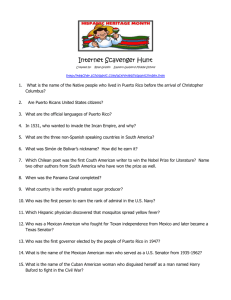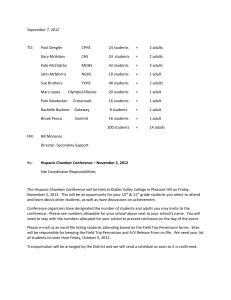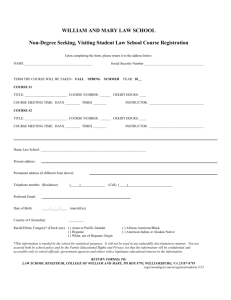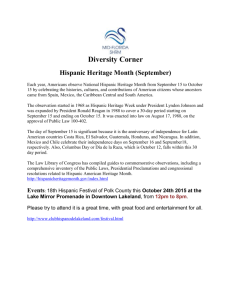An Overview of Cultural Differences
advertisement
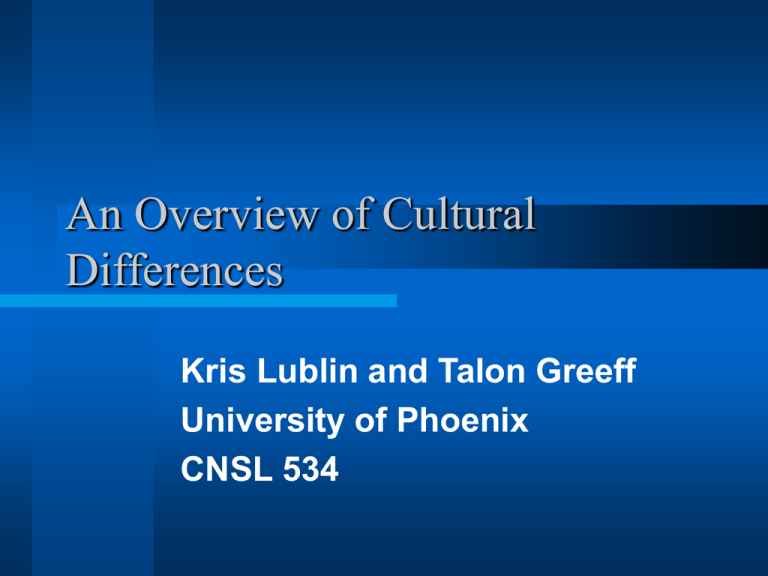
An Overview of Cultural Differences Kris Lublin and Talon Greeff University of Phoenix CNSL 534 Cultural differences impact many areas of an individual’s life: Medical Marketing Academic Lifestyle Leisure Counseling Attrition “Attrition is generally defined as the client’s failure to return for therapy. It is estimated that 50% of culturally diverse groups terminated therapy after only one contact with a mental health professional (Paniagua, 1998).” Introduction Utah Demographics Utah Minorities – – – – African-Americans Asian/Pacific-Islanders American Indians Latino • Hispanics • Mexicans Cultural Competency 1. Utah Statistics Not racially diverse compared to many other states Current demographics indicate increased diversity 2000 Census will verify and quantify the gains by minority groups in the State of Utah 1990 Census Demographics Caucasian---------87% Hispanics-----------5% Blacks-------------->1% American Indian--2% Asian/Pacific Islander--------------3% Other-----------------2% 2. Utah Minorities African-Americans Asian/PacificIslanders American Indians Latino • Hispanics • Mexicans • Puerto-Rican Americans • Cuban-Americans African-Americans Black vs. AfricanAmericans Treatment of Illnesses Spirituality Family Systems Counseling Implications Ask for client preference Use as combined or alternative treatment Include clergy Figure out who is head of household Asian/Pacific-Islanders Over 30 different groups Shared decisionmaking Silent communication Preservation of harmony Care for the elderly Counseling Implications Family-oriented treatment See therapist as figure of authority Show expertise and authority Alternative home care for elderly American Indians Family systems Non-verbal communication Concept of time Treatment of illnesses Counseling Implications Involvement of tribal members Set limits on time Use as combined or alternative treatment Access to Federal guidelines and resources Latino(a) Americans Latino(a)s includes individuals from each of these three areas of the world (Randall-David, 1993). Hispanic Americans Hispanic Americans, are residents of the United States who trace their ancestry to countries in the western hemisphere where the Spanish language is spoken. People of Hispanic background have lived in what is now the United States since the 17th century. Hispanic Americans In 1990 the U.S. census counted 22.3 million Hispanic Americans. An additional 2 to 3 million illegal Hispanic immigrants live in the United States. Hispanic Americans are the fastest-growing minority group Experts predict that Hispanic Americans will number more than 50 million by the year 2025. Mexican Americans Cinco de Mayo commemorates a Mexican military victory. On May 5, 1862, a relatively small Mexican force defeated invading French troops in the Battle of Puebla. Today, Cinco de Mayo celebrates Mexican culture and heritage. “Tex-Mex” “Tex-Mex” are Mexicans from Texas. Example of Musical style Sung in Spanish but its influenced by German and Czech polkas, waltzes, and other musical styles brought to the state by European settlers in the mid to late 1800s. Heard at weddings, anniversaries, graduation parties and festivals. Large population in South and Central Texas. Puerto Ricans The second largest subgroup with 2.7 million Puerto Ricans live in the United States, primarily in New York and New Jersey. Another 3.5 million live in Puerto Rico, a commonwealth associated with the United States. Received Federal benefits that some believe trapped them in poverty because of commonwealth status. Discrimination in employment and education trapped them. Percussionist Tito Puente, born in New York City to Puerto Rican parents, Cuban Americans Third largest subgroup Number about 1 million concentrated in Florida, especially in the Miami area. Cuban immigrants from 1958 mostly well-educated members of the middle and upper-middle classes, with a partial knowledge of English and a clear sense of national identity. Political force in Florida Other Hispanic Groups Since the 1970s, civil wars and economic turmoil in Latin America have brought substantial numbers of emigrants from other countries. About 500,000 Salvadorans immigrated to the United States during the 1980s. These Salvadoran immigrants settled primarily in Washington, D.C., Florida, Massachusetts, and California. Also in the 1980s, civil war in Nicaragua drove around 800,000 Nicaraguans to the United States. In the Dominican Republic, a shrinking job market and political unrest resulted in a large immigration of Dominicans to the United States, particularly to New York City. Colombian Americans, numbering about 352,000 in 1990, are the largest group of Hispanic Americans with roots in South America. Created distinct Hispanic American communities, each struggling to establish a unique identity in the United States. Hispanic Differences To varying degrees, Hispanic cultures have been influenced by Jewish, Muslim, Catholic, Spanish, African, Asian, and Native American traditions. Many people from Latin America are mestizos (people of mixed European and Native American ancestry) or mulattos (people of mixed African and European ancestry). Dealing with very educated and uneducated, poor and rich, legal and illegal--and all in between. Factor in the degree to which they have adopted “American” cultures and values. Attempts to unify Hispanic Americans under a single banner have often created tensions. Cuban Americans, Mexican Americans, and Puerto Ricans often have little in common. Easier to identify with other minorities. Cuban Americans have often allied themselves politically with Jewish Americans. Puerto Ricans have built similar alliances with African Americans. Mexicans are often characterized as dishonest, criminals and bums (RandallDavid, 1993) by other Hispanics. Counseling Implications Much diversity within the culture. Extended family is often important to clients. Behavior and its impact on family rather than self often important. Negative over-identification with culture can lead to dysfunction I.e. gang involvement. Language issues. Be Multiculturally competent. Who is he? Review Utah has small minority population Minority issues highlighted because they are such a small part of the population Cultural Competency Conclusion “Unintentional behavior is perhaps the most insidious form of racism. Unintentional racists are unaware of the harmful consequences of their behavior. They may be well-intentioned, and on the surface, their behavior may appear to be responsible….The major challenge facing counselors is to overcome unintentional racism and provide more equitable service delivery (Sue et al., 1998).” An Overview of Cultural Differences Kris Lublin and Talon Greeff This training presentation is available for download at: www.utahparenting.org © 2007 Utah Youth Village.
